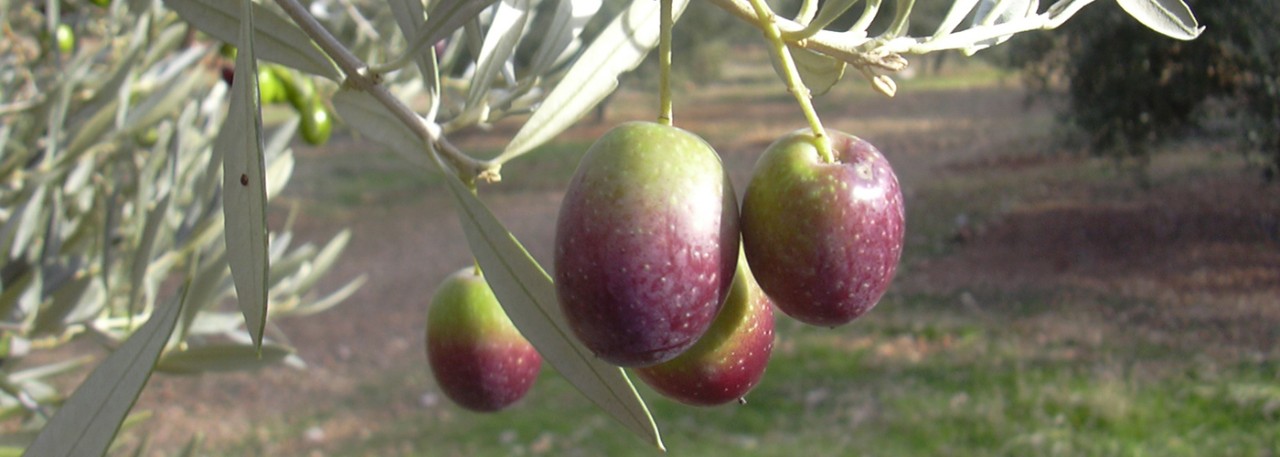.png.transform/rendition-xs/image_image%20(1).png)
Poniente de Granada PDO
Extra virgin olive oil obtained from the fruit of olive trees (Olea europea, L.) of varieties Picudo, Picual/Marteño, Hojiblanca, Lucio, Nevadillo de Alhama de Granada and Loaime.
Tasting notes
These oils offer a wide variety of aromas - fresh fruit, ripe fruit, grass, fig, etc. They are light, well balanced and rounded on the palate, with hints of bitterness and piquancy that harmonize nicely with others of sweetness. In color, they range from greenish yellow to golden yellow, depending on when the olives were harvested, the weather, olive variety and geographical location within the area.
Other notes
Thanks to their high concentrations of polyphenols, these are moderately stable oils. Because of the different varieties of olives used and the geographical environment, their fatty acid content is well balanced – an important dietary benefit. Levels of oleic acid are medium to high, as are those of linoleic acid, and the ratio of unsaturated to saturated fatty acids is also high.
Analytical data:
- Peroxide value: maximum 15 m.e.q. of active oxygen per kg of oil
- Ultraviolet absorbance (K270): maximum 0.15
- Moisture maximum: 0.2 per 100 for unfiltered and 0.1 per 100 for filtered oil.
- Impurities maximum: 0.1 per 100
Production / Processing method
Trees are laid out in rows to form a grid of squares; these are planted with two or three trees each to give a density ranging from 60 to 125 trees per hectare (2.5 acres). Over 85% of the olive groves are unirrigated and farmed by traditional local methods, which tend to be environmentally friendly.
Harvesting, which should be of ripe olives only, must be done by picking them directly off the tree using either the traditional method of shaking the branches with long poles, or mechanical vibrating equipment, or a combination of the two. The fruit must always be transported to the mill in bulk, in trucks or rigid drums. The mills must be of sufficient capacity to cope with the maximum quantities of olives delivered per day. Grinding must be done in registered mills, within at most 48 hours of harvesting.
The olives must be ground by the continuous method, using a hammer mill made of inert material approved for use in food processing. During malaxation of the olive pulp, the temperature must not be allowed to exceed 33º C (91.4º F) at any time. The only permitted co-adjuvant is certified food grade talc, at a maximum dose of 2.5%.
Separation must be carried out mainly by centrifugation. Only oils obtained from the first centrifugation of the olive paste are eligible to be certified. The temperature of water added to the horizontal centrifuge must not exceed 32º C (89.6º F), and the temperature of water used in the vertical centrifuge must also be controlled to prevent phase inversion occurring. The decantation process must last at least six hours in the case of centrifugation or 36 hours when it is done by gravity.
Extra virgin olive oil must be stored, in warehouses, in stainless steel or steel tanks lined with food grade cladding, or in traditional trujales. All such tanks must be completely closed in and have a lid that is removable for cleaning. They must also have a sloping base or one shaped like a truncated cone, and be fitted with sample-taking facilities. The warehouses and tanks must be climate controlled to avoid major temperature variations that would affect the qualities of the oil.
PDO oils may be transported in bulk only within the geographical limits of the production area. This means that the processing and packaging areas must coincide with the production area. The packaging plant must operate a traceability system applicable to the PDO oils it handles, and must use receptacles that guarantee food safety and do not endanger the oils’ quality or prestige.
Geography / Relief and climate
The production area’s environmental characteristics are typically Mediterranean with a Continental temperature range. However, by virtue of its location at the center of Andalusia, with a physical geography influenced by a large valley (the Genil basin) set in between two mountain systems (Subbaetic to the north and Baetic to the south), the area also has its own microclimate. This is characterized by typically Continental extreme temperatures, with long, cold winters and long, hot summers, and big temperature shifts between winter and summer, night and day. This pattern of extremes affects the final stage of the olive’s ripening, increasing levels of oleic acid and the ratio of unsaturated to saturated fatty acids. It also affects the olive’s polyphenol content, increasing its concentration.
The main differentiating characteristic of these oils is that they come from different combinations of olive varieties. Mixing olive varieties within the same grove is an ancient local practice, motivated by two factors. First, the belief that it helps the trees to pollinate, and second, the fact that it stabilizes production, compensating for the irregular yields of vineyards that respond to weather conditions that differ from one year to the next as they typically do in this area.
Regulatory Council
Consejo Regulador de la DOP Poniente de Granada
C/ Cantaor Manuel Ávila, s/n - Centro Etnológico de Montefrío
18270 Montefrío (Granada)
Tel: (+34) 958 336 879
info@doponientedegranada.com
www.doponientedegranada.com
Sources:
- Spanish Ministry of Agriculture
Their fatty acid content is well balanced and an important dietary benefit.


- Poniente de Granada 1
- Poniente de Granada 2
